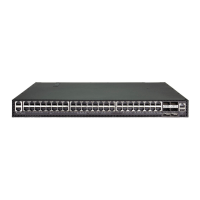C
HAPTER
18
| Using the Command Line Interface
Entering Commands
– 682 –
PARTIAL KEYWORD
LOOKUP
If you terminate a partial keyword with a question mark, alternatives that
match the initial letters are provided. (Remember not to leave a space
between the command and question mark.) For example “s?” shows all the
keywords starting with “s.”
Console#show s?
snmp snmp-server sntp spanning-tree ssh
startup-config subnet-vlan system
Console#show s
NEGATING THE EFFECT
OF COMMANDS
For many configuration commands you can enter the prefix keyword “no”
to cancel the effect of a command or reset the configuration to the default
value. For example, the logging command will log system messages to a
host server. To disable logging, specify the no logging command. This
guide describes the negation effect for all applicable commands.
USING COMMAND
HISTORY
The CLI maintains a history of commands that have been entered. You can
scroll back through the history of commands by pressing the up arrow key.
Any command displayed in the history list can be executed again, or first
modified and then executed.
Using the show history command displays a longer list of recently
executed commands.
UNDERSTANDING
COMMAND MODES
The command set is divided into Exec and Configuration classes. Exec
commands generally display information on system status or clear
statistical counters. Configuration commands, on the other hand, modify
interface parameters or enable certain switching functions. These classes
are further divided into different modes. Available commands depend on
the selected mode. You can always enter a question mark “?” at the
prompt to display a list of the commands available for the current mode.
The command classes and associated modes are displayed in the following
table:
Table 41: General Command Modes
Class Mode
Exec Normal
Privileged
Configuration
Global
*
Access Control List
CFM
Class Map
ERPS
IGMP Profile
Interface
Line
Multiple Spanning Tree
Policy Map

